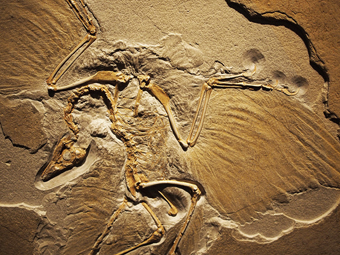THE THEOLOGICAL ENGINEER
Archaeopteryx
Evolution's "missing link" or just a fossil for the birds?
By Jeff Laird

Scientists have found around ten fossilized specimens of Archaeopteryx, though there is some controversy over whether they are all actually the same species. The name comes from a combination of the Greek words for "ancient" and "feather," so named because the presence of feathers was what made the first find so interesting. After the initial discovery in the 1860s, scientists have determined that Archaeopteryx was not the actual ancestor of modern birds, but it is the earliest fossil to have certain traits found in modern birds. It is often heralded as "proof" of evolution, and as a clear example of a transitional form.
Transitional forms are animals that represent a mid-point between distant phases of evolution. In the case of Archaeopteryx, the transition is supposedly between dinosaurs and modern birds. While this animal does share certain traits of both, claiming it as a transitional form runs into some difficulties. As noted above, modern paleontology doesn't actually consider Archaeopteryx to be an ancestor of birds. Also, the mere presence of common features doesn't necessarily imply common genetics or ancestry. This can be seen even in animal groups today that have some very similar features, but are not even remotely genetically related.
In the case of Archaeopteryx, there are many modern birds that have similar traits, some of which are also common to reptiles. Obviously, modern birds cannot be their own ancestor, so having comparable features doesn't necessarily make Archaeopteryx a predecessor to modern birds. Also, there are more critical traits of birds for which no origin has been found, such as a transition from scales to feathers, or the development of actual flight. The point is that common features certainly don't "prove" common ancestry, though of course "missing features" don't absolutely disprove it, either.
The greater issue with transitional forms is not that there are a few possible examples — it's that there should be so many more than there are. Imagine the evolution of animals as a film reel — a long, detailed process with millions and millions of individual frames. Typical talk of "transitional forms" makes it sound as though science has most of the film, and these forms fill in the rare missing spots in the movie. In reality, what science has is a small handful of frames, and the vast, overwhelming majority of the movie is missing. This is true even in conditions where fossilization is relatively common.
Also, what scientific records actually show are multiple new life forms arising suddenly, explosively, and without "transitional" changes in traits. That doesn't disprove evolution (theistic or naturalistic), but it does raise some serious questions about whether the popular perception is really accurate. Advancing scientific knowledge has actually reduced the number of animals considered as candidates for transitional forms. What were once considered established chains of transitional evolution, such as horses, have since been abandoned once more information was discovered. In other words, science started out with almost every link being a "missing link," and now there even fewer.
In and of itself, Archaeopteryx doesn't really prove anything one way or the other about evolution. Despite its status in pop culture, this animal is neither proof of any particular form of evolution, nor one of "many" transitional forms. It's a single example of a creature with similar features to two animal groups, but lacking any good scientific evidence linking it to both. The "missing link" phrase so often used is misleading, because it implies that we know all but a few of the steps. In reality, we know almost none of them.
Image Credit: Denise Chan; "archaeopteryx"; Creative Commons
Tags: Controversial-Issues | Current-Issues | False-Teaching | History-Apologetics | Science-Creation
comments powered by Disqus
Published 4-18-16

